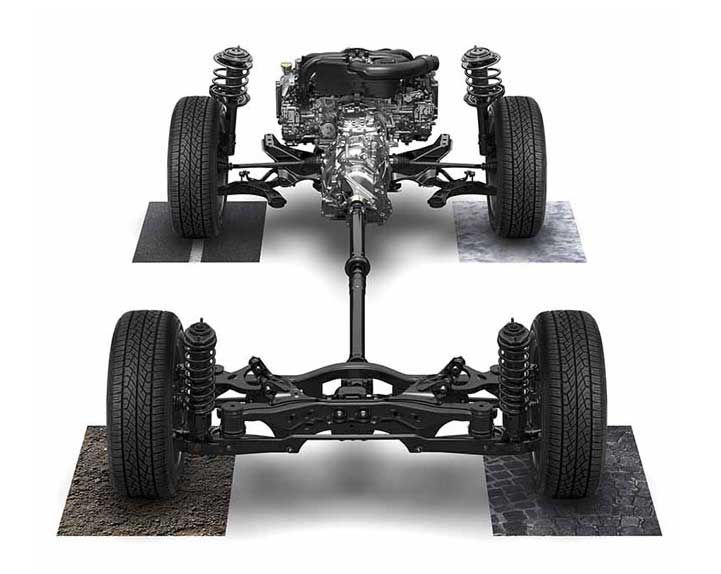All-Wheel Drive
AWD, refers to a system where all four wheels can gain traction independently of each other. The difference between AWD and 4WD is that AWD is typically always on while you can toggle between having 4WD on and off. 4WD is an addition you’ll usually find on a truck, while AWD is more for cars and SUVs.
All-wheel drive is added to a car by giving it three differentials, or gear boxes, in different parts of the car. You’ll find the three gear boxes on the front, center, and rear of your car, and these differentials mean your four tires can get traction independently of each other, allowing for superior traction and handling in all types of weather situations.
Four-Wheel Drive
What is 4×4? 4×4, also known as four-wheel drive or 4WD, is a system where the engine powers all four wheels evenly. This type of system is excellent for heavy-duty hauling and other work activities, which is why you’ll typically find it on a pickup truck. You’ve usually got two 4WD options for your East St. Louis driving pleasure, 4WD Low for those tough towing jobs, and 4WD High for when you need to correctly balance your inside and outside wheels for tough terrain.
4WD vs. AWD vs. 2WD, there are pros and cons to both, and the main distinction is traction. This can be traction during extreme weather conditions like snow or mud or traction that’s better for handling and speed. As you’re learning about both options, it’s good to compare the two, which you can do below.
2WD vs. 4WD: What’s the Difference?
You’re probably wondering how 2WD vs. 4WD compares. To start, you’ll want to know what 2WD means. This is when only two of the four wheels put the vehicle in motion and keep it moving. There are only two kinds: front-wheel drive (FWD) and rear-wheel drive (RWD). Like the previous sections, both have their advantages and disadvantages. Compare 2WD vs. 4WD:
FWD: Newer cars and SUVs use front-wheel drive, which is where the engine’s power gets routed to the front wheels. FWD has the advantage of better traction while driving uphill or on slippery roads. They also compromise the sporty performance of a vehicle while offering the right balance for everyday driving and usability.
RWD: Rear-wheel drive vehicles offer better acceleration and transformation than FWD vehicles. They’re pushing their weight ahead instead of pulling it, and initiating a turn from the rear is much easier, which is why it’s commonly found on pickup trucks and truck-based SUVs.
Is AWD Better Than 4WD?
We’ve compared 2WD vs. 4WD, but how does 4WD vs. AWD compare? Is one better than the other? Neither of the two options is specifically “better” than the other; it depends on what you need AWD or 4WD for. AWD and 4WD provide better handling, but you’d want AWD if you ride on rough roads during harsh weather, while 4WD is better for those who have heavy hauls on the jobsite.
Subaru has made a name for itself because of it’s Symmetrical All-Wheel Drive (AWD) system. If you look at a Subaru’s drivetrain, you’ll notice that one side is just a mirror image of the other. While the symmetry may not seem important, it’s actually safer than normal AWD system. The symmetry allows for better balance of the vehicle giving you better control as a driver.

The key feature with Symmetrical AWD is that it sends power to all four wheels continuously. In All-Wheel Drive, that only happens after the vehicle senses slippage and may not be able to react in time. Symmetrical All-Wheel Drive greatly reduces the chances of you slipping in the first place, making it a much safer option.
Last but certainly not least, Symmetrical AWD is more efficient allowing your vehicle to last longer. It uses fewer components and loses less power due to friction compared to normal All-Wheel Drive systems. Therefore, not only will you be safer when you drive a Subaru, but you will also be getting your money’s worth.

